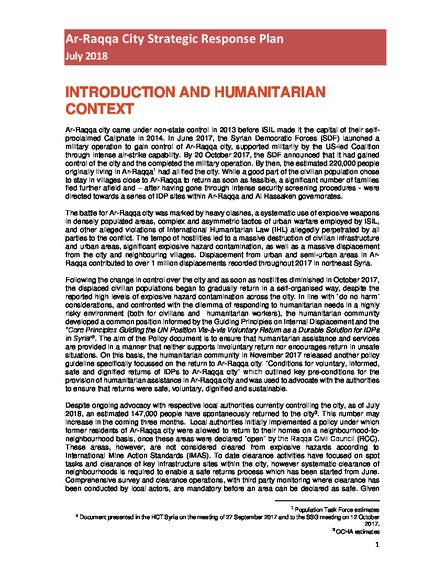
Ar-Raqqa city came under non-state control in 2013 before ISIL made it the capital of their selfproclaimed Caliphate in 2014. In June 2017, the Syrian Democratic Forces (SDF) launched a military operation to gain control of Ar-Raqqa city, supported militarily by the US-led Coalition through intense air-strike capability. By 20 October 2017, the SDF announced that it had gained control of the city and the completed the military operation. By then, the estimated 220,000 people originally living in Ar-Raqqa had all fled the city. While a good part of the civilian population chose to stay in villages close to Ar-Raqqa to return as soon as feasible, a significant number of families fled further afield and – after having gone through intense security screening procedures - were directed towards a series of IDP sites within Ar-Raqqa and Al Hassakeh governorates.
The battle for Ar-Raqqa city was marked by heavy clashes, a systematic use of explosive weapons in densely populated areas, complex and asymmetric tactics of urban warfare employed by ISIL, and other alleged violations of International Humanitarian Law (IHL) allegedly perpetrated by all parties to the conflict. The tempo of hostilities led to a massive destruction of civilian infrastructure and urban areas, significant explosive hazard contamination, as well as a massive displacement from the city and neighbouring villages. Displacement from urban and semi-urban areas in ArRaqqa contributed to over 1 million displacements recorded throughout 2017 in northeast Syria. Following the change in control over the city and as soon as hostilities diminished in October 2017, the displaced civilian populations began to gradually return in a self-organised way, despite the reported high levels of explosive hazard contamination across the city. In line with “do no harm” considerations, and confronted with the dilemma of responding to humanitarian needs in a highly risky environment (both for civilians and humanitarian workers), the humanitarian community developed a common position informed by the Guiding Principles on Internal Displacement and the “Core Principles Guiding the UN Position Vis-à-vis Voluntary Return as a Durable Solution for IDPs in Syria” .
The aim of the Policy document is to ensure that humanitarian assistance and services are provided in a manner that neither supports involuntary return nor encourages return in unsafe situations. On this basis, the humanitarian community in November 2017 released another policy guideline specifically focussed on the return to Ar-Raqqa city: “Conditions for voluntary, informed, safe and dignified returns of IDPs to Ar-Raqqa city” which outlined key pre-conditions for the provision of humanitarian assistance in Ar-Raqqa city and was used to advocate with the authorities to ensure that returns were safe, voluntary, dignified and sustainable.
Links
Resource collections
- Topics
- UN Habitat - Urban Response Collection
- Urban Response - Urban Crisis Preparedness and Risk Reduction
- Urban Response Collection - Community Engagement and Social Cohesion
- Urban Response Collection - Economic Recovery
- Urban Response Collection - Environment and Climate Change
- Urban Response Collection - Housing, Land and Property
- Urban Response Collection - Urban Crisis Response, Recovery and Reconstruction
- Urban Response Collection - Urban Resilience
